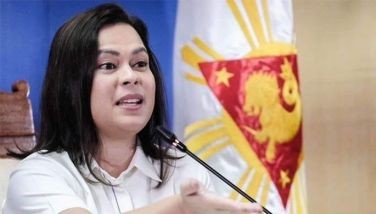Honasan, RAM boys say people power not dead
February 23, 2006 | 12:00am
People power remains the strongest political force capable of steering the nation toward development and economic prosperity, a key figure in the 1986 EDSA revolt that ousted the Marcos dictatorship said yesterday.
Speaking at the 20th anniversary celebration of the civilian/military uprising at Club Filipino in San Juan, former senator Gregorio Honasan said people power is as unstoppable as the truth, and a weapon that can be harnessed for national unity, development and economic prosperity.
"It is the strongest political and moral force that is available to any responsible government," he said. "People power is not obsolete, it is very much alive."
On the other hand, former national security adviser Jose Almonte, who was also a member of the Reform the Armed Forces Movement (RAM) led by Honasan, said people power remains a mechanism for change, but that true people power cannot be bought.
"There is a claim that people power is dead. I disagree with that," he said.
"That is a misunderstanding of what is people power. If you say people power is dead, that is equivalent to saying that the sovereign people have abdicated their right to control their future. That is never the case."
Honasan, Almonte and other RAM members held a simple but touching ceremony to celebrate the 20th anniversary of EDSA I at Club Filipino in Greenhills, San Juan yesterday.
RAM initiated the people power revolt at 2 p.m. on Feb. 22, 1986 in a bid for reforms in the Armed Forces of the Philippines, a clamor for good governance and an end to the 20-year rule of President Ferdinand Marcos.
"Maybe EDSA ’86 is a work in progress, but every time we talk about EDSA it seems to resonate divisive spirit among our people, whom we tried to unite," Honasan said.
"What we wanted during EDSA I were very simple issues like restoring ethics, fair-mindedness, order, righteousness and morale, to a very precious organization to all of us, the AFP (Armed Forces of the Philippines), that we love so much."
Honasan, who led a bloody coup that almost toppled President Corazon Aquino in 1989, said the nation was again calling the RAM back, not only from its material, but also from its mental "comfort zone."
"I’m not saying we go out of our comfort zone and agitate," he said.
"(We) go out of our comfort zone and then dialogue, hoping this will provoke national dialogue, poverty, justice system, electoral reforms, professional governance, and (improved) ability to respond to national calamity."
Almonte said EDSA I had placed the Philippines on the world map as a country that managed to topple a dictatorship through a military-backed people power uprising.
Speaking at the 20th anniversary celebration of the civilian/military uprising at Club Filipino in San Juan, former senator Gregorio Honasan said people power is as unstoppable as the truth, and a weapon that can be harnessed for national unity, development and economic prosperity.
"It is the strongest political and moral force that is available to any responsible government," he said. "People power is not obsolete, it is very much alive."
On the other hand, former national security adviser Jose Almonte, who was also a member of the Reform the Armed Forces Movement (RAM) led by Honasan, said people power remains a mechanism for change, but that true people power cannot be bought.
"There is a claim that people power is dead. I disagree with that," he said.
"That is a misunderstanding of what is people power. If you say people power is dead, that is equivalent to saying that the sovereign people have abdicated their right to control their future. That is never the case."
Honasan, Almonte and other RAM members held a simple but touching ceremony to celebrate the 20th anniversary of EDSA I at Club Filipino in Greenhills, San Juan yesterday.
RAM initiated the people power revolt at 2 p.m. on Feb. 22, 1986 in a bid for reforms in the Armed Forces of the Philippines, a clamor for good governance and an end to the 20-year rule of President Ferdinand Marcos.
"Maybe EDSA ’86 is a work in progress, but every time we talk about EDSA it seems to resonate divisive spirit among our people, whom we tried to unite," Honasan said.
"What we wanted during EDSA I were very simple issues like restoring ethics, fair-mindedness, order, righteousness and morale, to a very precious organization to all of us, the AFP (Armed Forces of the Philippines), that we love so much."
Honasan, who led a bloody coup that almost toppled President Corazon Aquino in 1989, said the nation was again calling the RAM back, not only from its material, but also from its mental "comfort zone."
"I’m not saying we go out of our comfort zone and agitate," he said.
"(We) go out of our comfort zone and then dialogue, hoping this will provoke national dialogue, poverty, justice system, electoral reforms, professional governance, and (improved) ability to respond to national calamity."
Almonte said EDSA I had placed the Philippines on the world map as a country that managed to topple a dictatorship through a military-backed people power uprising.
BrandSpace Articles
<
>
- Latest
- Trending
Trending
Latest
Trending
Latest
Recommended































